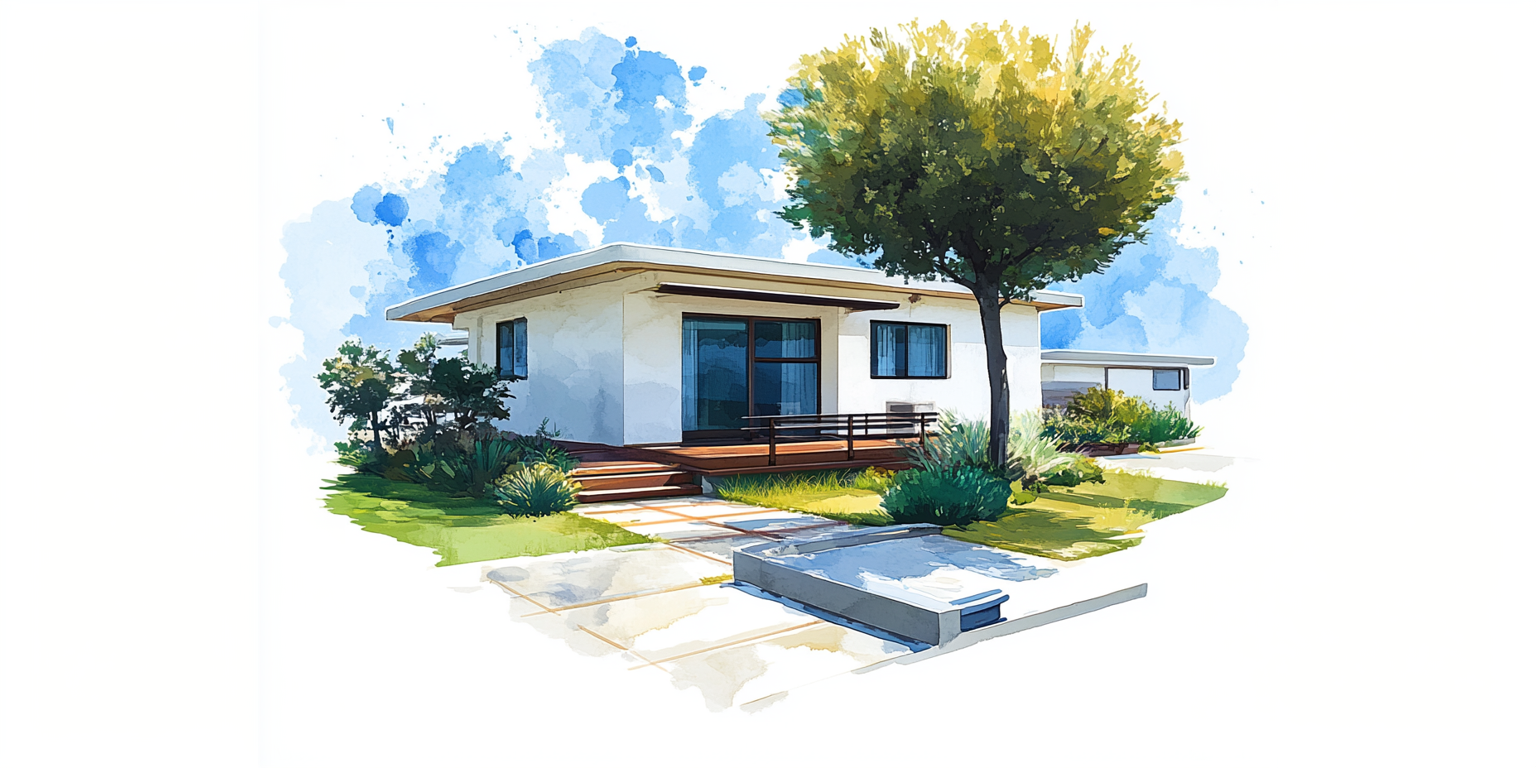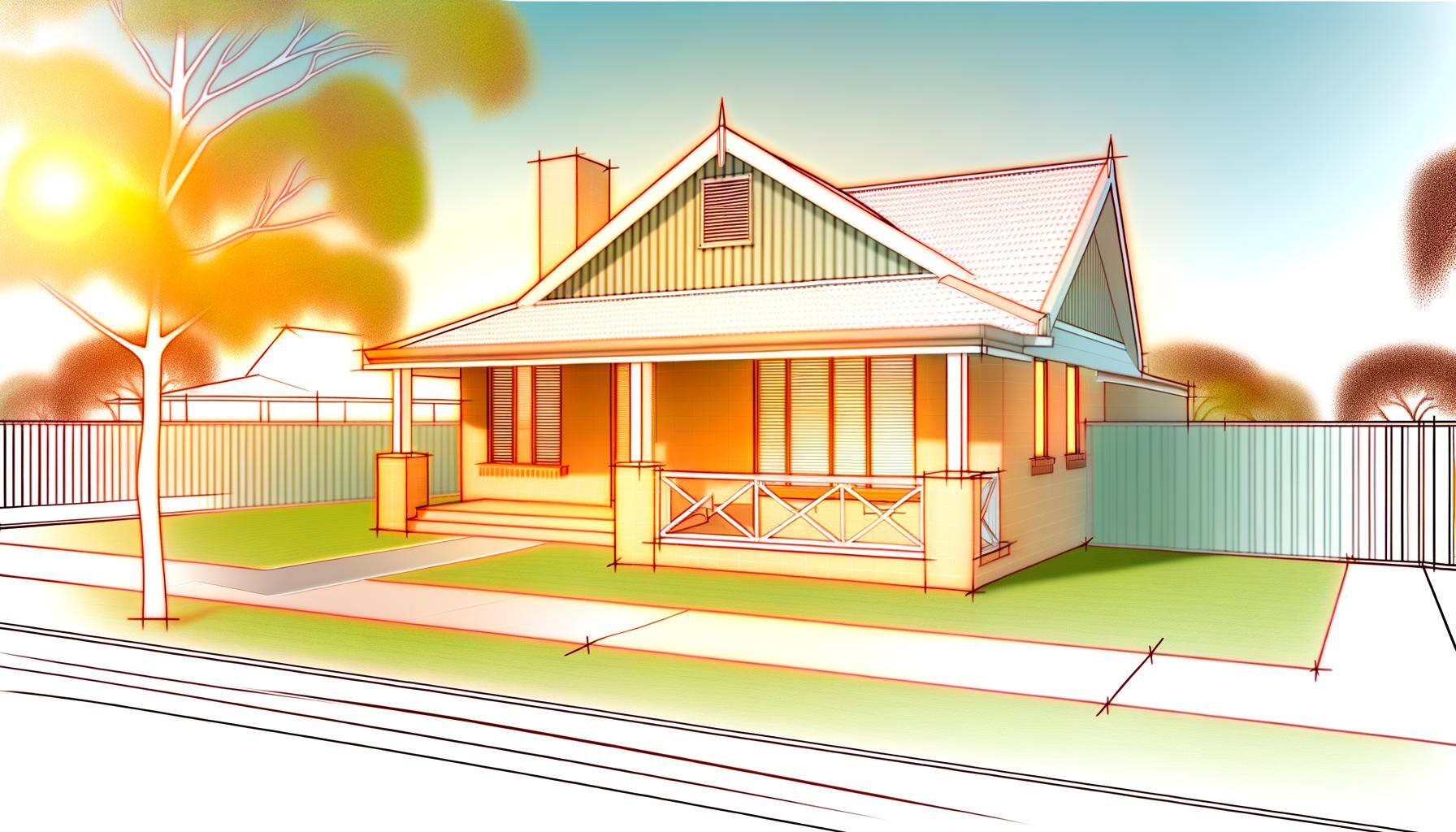So what sets a 7 star home apart in the world of energy efficient living?
To start, let’s dive into what the benefits of 7 Star Homes really are and why Energy Efficiency is taking over the construction and design industry.
In this article, we’re going to discuss:
- Understanding the NatHERS Star Rating System
- Benefits of 7 Star Homes
- How to get a 7 Star Home Rating?
- The Process of Upgrading to 7 Stars
- Why Energy Efficient Homes are the Future of Design?
Introduction: The Future of Housing is Energy Efficient
In an era of rapid climate change and rising living costs, energy-efficient homes have moved from being a trend to becoming the cornerstone of modern design. For homeowners and architects alike, energy efficiency is no longer just a “nice-to-have” but an essential aspect of building and living in Australia’s future.
Historically, residential construction has been guided by aesthetics and functionality rather than sustainability. Yet, as people’s priorities shift, so does the expectation of what a home should provide. Today’s homes must do more than just shelter us; they must enhance our quality of life and reduce our environmental impact. This is where the Nationwide House Energy Rating Scheme (NatHERS) steps in. Initiated in 1993 by the Australian and New Zealand Minerals and Energy Council (later the Ministerial Council on Energy) NatHERS is setting a measurable standard that guides architects and developers to create homes that serve both their occupants and the planet. A 7 Star rating on the NatHERS scale signals that a home is built not just to be occupied but to coexist with its surroundings, using strategic design to reduce reliance on artificial heating and cooling.
For architects, developers, and homeowners, this shift represents an opportunity to be part of a sustainable movement that will define future urban landscapes. It’s not simply about meeting regulatory requirements; it’s about creating a legacy of responsible design. By investing in energy-efficient design today, we’re not only preparing our homes for the demands of tomorrow but also setting a precedent for healthier, smarter, and more sustainable communities.
Understanding the NATHERS Star Rating System
NatHERS is a cornerstone in Australia's drive towards creating more energy-efficient homes. By providing a standardised measure of a home’s thermal performance, NatHERS plays a crucial role in guiding homeowners, builders, and architects towards more sustainable construction practices. The system assesses the potential energy use of a home for heating and cooling, using a star rating that ranges from 0 to 10. This rating identifies how efficiently a house can maintain a comfortable indoor temperature.
What is the NatHERS Rating?
Introduced in 1993, NatHERS leverages advanced computer simulations to evaluate a home’s energy performance. The system considers multiple factors including the building’s design, construction materials, orientation, and local climate conditions. These elements are simulated to predict the annual energy required to maintain comfort within the home, which is then converted into a star rating.
A home with a 0-star rating offers almost no protection from the external environment, making it highly dependent on artificial heating and cooling. Conversely, a home with a 10-star rating is capable of maintaining comfortable temperatures year-round with minimal energy use. According to the Australian Government, the average star rating for new homes in 2021 was approximately 6 stars, indicating that there is still significant room for improvement in energy efficiency (NatHERS, 2021).
The Significance of Each Star
Every additional star on the NatHERS scale reflects a notable improvement in energy efficiency. Here’s a breakdown of what each star rating typically indicates:
- 0-2 Stars: Homes with low star ratings are poorly insulated, resulting in high energy consumption to achieve thermal comfort.
- 3-4 Stars: These homes show some improvement but still rely heavily on artificial heating and cooling.
- 5-6 Stars: This range signifies a balance between energy efficiency and comfort, with better insulation and design elements.
- 7-8 Stars: Homes are highly efficient, maintaining comfortable temperatures with reduced reliance on external energy sources.
- 9-10 Stars: Exemplifying the highest level of thermal efficiency, these homes require minimal energy to stay comfortable throughout the year.
The Impact of Star Ratings on Home Design
Achieving a higher NatHERS star rating necessitates strategic architectural design and the incorporation of advanced materials. Double-glazed windows, superior insulation, and smart orientation are just a few elements that contribute to higher star ratings. Builders and architects must take local climate conditions into account and utilise passive design principles to maximise a home’s thermal performance.
Regulatory Trends and Future Directions
The drive towards higher NatHERS ratings is bolstered by various regulatory measures and incentives from the government. The National Construction Code (NCC) has been progressively tightening energy efficiency requirements for new homes, aiming to raise the minimum standards over time. This push towards higher star ratings is expected to continue, making 7 Star Homes the new benchmark for energy efficiency in Australia (Australian Building Codes Board, 2022).
Benefits of 7 Star Homes
7 Star Homes are on the cutting edge of sustainable residential design, offering benefits that go beyond energy and cost savings. Here, we’ll explore some advantages that highlight why these homes are truly transformative.
Energy Savings and Cost Reduction
One of the most significant benefits of 7 Star Homes is their ability to drastically reduce energy consumption, leading to substantial cost savings for homeowners. By achieving high levels of thermal efficiency, these homes minimise the need for artificial heating and cooling, which are often the most significant contributors to household energy bills. According to the NCC, homeowners in NSW with a 7 star home have energy bill savings of around $326 per year. (Australian Building Codes Board, 2022). This reduction in costs and energy usage not only benefits the homeowner but also contributes to a more sustainable future.
Health and Wellbeing
The impact of 7 Star Homes on health and wellbeing is often overlooked. Homes with higher energy ratings tend to have better indoor air quality, as they are designed to minimise pollutants and maintain optimal ventilation. This can lead to a reduction in respiratory issues and allergies. Furthermore, consistent indoor temperatures contribute to better sleep and overall health, as the body does not have to work hard to adjust to temperature extremes (Australian Building Codes Board, 2022, p. 15).
Noise Reduction
An unexpected benefit of the superior insulation and building materials used in 7 Star Homes is noise reduction. The same features that keep the home energy-efficient also block out external noise, creating a more peaceful and serene living environment. This is particularly beneficial in urban areas where noise pollution can be a significant issue.
Resilience in a Changing Climate
One of the benefits of 7 Star Homes is their resilience to climate change. As weather patterns become more unpredictable and extreme temperatures more common, homes that are designed with superior thermal performance can better withstand these conditions. Enhanced insulation and strategic design elements ensure that 7 Star Homes remain comfortable regardless of external weather fluctuations, making them a smart long-term investment in an era of climate uncertainty.
Future-Proofing Your Investment
Investing in a 7 Star home is not just about immediate benefits, but also about future-proofing your property. As energy efficiency standards continue to rise and regulations become stricter, homes with higher ratings are likely to retain and even increase their value. Buyers are becoming more educated about energy efficiency and are willing to pay a premium for homes that meet higher standards. This trend is expected to continue, making 7 Star Homes a solid investment for the future (Domain, 2022).
Contribution to National Energy Goals
Australia has committed to reducing greenhouse gas emissions and improving energy efficiency across various sectors, including residential buildings. By adopting 7 Star home designs, homeowners are not only benefiting themselves but also playing a part in achieving these national objectives. This collective effort can lead to significant environmental benefits and help the country meet its international commitments on climate change (Energy Facts Australia, 2023).
Enhanced Aesthetic and Design Innovation
The journey to achieve a 7 Star rating often results in homes that are architecturally distinctive. The need for precise thermal performance encourages architects to think creatively about design elements such as window placement, shading devices, and the use of sustainable materials. This focus on innovative design ensures that 7 Star Homes are not only efficient but also visually appealing and comfortable to live in.
Summing Up
The benefits of 7 Star Homes extend far beyond simple energy savings. They offer enhanced resilience, health benefits, noise reduction, future-proofing, support national energy goals, and inspire architectural innovation. These multifaceted advantages make 7 Star Homes an exemplary model of modern, sustainable living.
How to get a 7 Star Home Rating?
Achieving a 7-star NatHERS rating is a commendable goal that ensures a home is designed and built with care and consideration for the environmental needs of its occupants and the planet. This process involves meticulous planning, the use of quality materials, and professional assessments. Here’s a comprehensive guide on how to secure a 7-star rating for your home.
sTEP 1: Design and Planning
The journey to a 7-star home begins at the design and planning stage. This phase is crucial as it sets the foundation for all subsequent steps. Key considerations include:
- Orientation and Layout
Proper orientation maximises natural light and heat, reducing the need for artificial lighting and heating. In Australia, north-facing windows are ideal for capturing winter sun while minimising summer heat gain. The layout should also promote natural ventilation, allowing cool breezes to flow through the home. - Passive Solar Design
Incorporate passive solar design principles to enhance energy efficiency. This involves strategic placement of windows, shading devices, and materials with a high thermal mass (like concrete or brick) to absorb and ‘’store heat from the sun during the day and release it when it is required, to offset heat loss to colder night-time temperatures or cloudy days. It effectively ‘evens out’ temperature variations between day and night” (Your Home, n.d.) By harnessing solar energy, the home can maintain a comfortable temperature year-round without excessive energy use.
sTEP 2: cONSIDER Construction Materials and Techniques
Selecting the right materials and construction techniques is vital for achieving a high energy rating. Consider the following:
- Insulation
High-quality insulation is one of the most effective ways to improve a home’s thermal performance. Insulate walls, roofs, and floors to prevent heat loss in winter and heat gain in summer. Materials such as wool, cellulose, and rigid foam offer excellent thermal insulative properties. - Windows and Glazing
Opt for energy-efficient windows with double or triple glazing. These windows reduce heat transfer, helping to maintain a stable indoor temperature. Low-emissivity (Low-E) coatings on glass can further enhance insulation by reflecting infrared light. - Sealing and Draft Proofing
Ensure the home is well-sealed to prevent drafts and air leakage. Pay attention to gaps around doors, windows, and other openings. Effective sealing reduces the workload on heating and cooling systems, thereby lowering energy consumption.
sTEP 3: Getting a Professional Assessment Report
You will need to engage an Accredited Assessor early in the process to guide design choices and ensure compliance with NatHERS requirements. Only assessors trained, certified, and accredited by one of the two nationally operating Assessor Accrediting Organisations (AAOs) can use NatHERS second-generation thermal assessment software to provide official thermal efficiency star ratings and issue relevant certificates. The two AAOs are the Australian Building Sustainability Organisation (ABSA) and the Building Designers Association Victoria (BDAV).
At Certified Energy, our assessors are accredited by ABSA. (Certified Energy, 7 Star NatHERS Certificate)
- Simulation Model
A NatHERS accredited assessor will enter data into the software which will generate a simulation model of the dwelling. The simulation model will include: sizes and functions of the rooms, sizes and specification of openings, building materials/windows/products, type of construction, dwelling orientation, and location. - Thermal Modelling
The Simulation model is then used to determine the level of artificial heating or cooling that is needed for occupants to remain comfortable within the home. The construction type materials, glazing, lighting, and insulation are used to assess the overall annual thermal performance of the project based on the development’s total heating and cooling loads throughout the year. - Calculating a Rating
Once the steps above have been completed, the total annual estimated levels of energy-efficient heating and cooling are determined by a ranking out of 10 stars. A higher star rating indicates better thermal performance and energy efficiency.
In Summary
Securing a 7-star NatHERS rating requires a holistic approach, integrating considerate design practices, materials, and professional expertise.
The Process of Upgrading to 7 Stars
Achieving a 7-star NatHERS rating for an existing home involves a strategic approach to enhance thermal performance. Here's a comprehensive guide on the steps involved in upgrading to a 7-star rating.


Step 1: Identifying Areas for Improvement
The first step in the upgrade process is to conduct a thorough energy audit to identify areas where the home’s thermal performance can be improved. An Accredited Assessor will perform this audit, examining various elements such as insulation, windows, glazing, and the overall building envelope using NatHERS approved software. This will highlight areas where energy losses occur and where improvements can be made.
Step 2: Implementing Upgrades
Once the areas for improvement have been identified, the next step is to implement targeted upgrades and put them to the test within the NatHERS software. This can involve several actions
- Improving Insulation: Enhancing the insulation in walls, roofs, and floors is one of the most effective ways to improve thermal performance. High-quality insulation materials such as wool, cellulose, and rigid foam should be used to minimise heat transfer and maintain stable indoor temperatures.
-
Upgrading Windows and Glazing: Replacing single-glazed windows with double or triple glazing can significantly reduce heat loss and gain. Additionally, using windows with low-emissivity (Low-E) coatings can reflect infrared light, further improving insulation. Proper sealing around windows and doors is also crucial to prevent drafts and air leakage.
-
Optimising HVAC Systems: Upgrading or optimising the heating, ventilation, and air conditioning (HVAC) systems can enhance energy efficiency. This includes installing energy-efficient units, ensuring proper maintenance, and using programmable thermostats to control indoor temperatures more effectively.
-
Enhancing Shading and Ventilation: Implementing shading solutions such as awnings, blinds, and reflective roofing materials can reduce heat gain in the summer. Enhancing natural ventilation through strategic window placement and using ceiling fans can also help maintain comfortable temperatures without relying heavily on HVAC systems.
Step 3: Reassessment and Certification
Once Improvements for the Home have been decided upon, a reassessment is conducted to ensure the home meets the 7 Star rating criteria. The process involves:
The Accredited Assessor inputting the home’s modified details into the NatHERS software to reassess its thermal performance. The software uses the updated data to determine the total annual heating and cooling loads.
If the reassessment confirms that the home meets the 7 Star criteria, the assessor will issue an official NatHERS certificate. This certificate serves as proof of the home’s enhanced energy efficiency and will be needed to demonstrate compliance with energy efficiency regulations and standards.
Step 4: Congratulations you’ve made it to 7 Stars!
Time to enjoy all that hard work in your highly energy efficient home whilst you decide what you will buy with this extra money you’re now saving.
Why Energy Efficient Homes are the Future of Design
Energy-efficient homes are set to dominate the future of residential design, not only for their obvious benefits but also due to several unique and under appreciated factors. These homes are at the forefront of addressing contemporary challenges and paving the way for sustainable living in ways that many traditional designs overlook.
Building Community Resilience
Energy-efficient homes contribute to the resilience of communities, an often-overlooked benefit. By reducing the strain on local energy grids and promoting self-sufficiency, these homes help communities withstand energy crises and natural disasters. This resilience is particularly important in areas prone to extreme weather events. Energy-efficient communities can maintain critical functions and support each other during disruptions, fostering a sense of solidarity and collective responsibility.
Educational and Behavioural Impact
The design of energy-efficient homes also has a profound educational impact. Living in such homes makes occupants more aware of their energy consumption patterns and encourages sustainable behaviours. Over time, this awareness can lead to broader changes in lifestyle and consumption habits, promoting a culture of sustainability that extends beyond the home. These behavioural shifts are essential for achieving long-term environmental goals and fostering a more sustainable society (Australian Institute of Architects, 2022).
Technological Innovation
Energy-efficient homes are catalysts for technological innovation in the construction industry. The drive to achieve higher energy ratings pushes architects, engineers, and builders to develop new materials, construction techniques, and design strategies. This innovation not only improves the efficiency of individual homes but also advances the entire field of sustainable architecture, leading to better practices and more effective solutions across the industry.
Conclusion
Energy-efficient homes are the future of residential design due to their profound impact on sustainability, resource efficiency, and climate resilience. These homes go beyond simply reducing utility bills; they offer enhanced comfort, improved health, and a reduced environmental footprint. As urbanisation accelerates and climate change presents new challenges, energy-efficient homes provide a solution that aligns with both present and future needs.
Ultimately, energy-efficient homes are the future of design because they address the critical issues of our time—sustainability, health, and economic efficiency. By investing in these homes, we are not only securing a better quality of life for ourselves but also paving the way for a sustainable and resilient future for generations to come. These homes are more than just a response to current environmental challenges; they are a proactive step towards a sustainable and resilient future.
References:
Australian Building Codes Board. (2022). National Construction Code. Retrieved from ABCB website. NCC 2022 residential energy efficiency.
Australian Building Codes Board. (2022). Handbook: Indoor air quality. Retrieved from ABCB website.
Australian Institute of Architects. (2022). Sustainable Behaviours through Home Design. https://www.architecture.com.au/
Domain. (2022). What is a 7 Star house, and are they worth more? Retrieved from https://www.domain.com.au/advice/what-is-a-7 Star-house-and-are-they-worth-more-1165241/
Energy Facts Australia. (2023). Energy efficiency. Retrieved from https://www.energyfactsaustralia.org.au/key-issues/energy-eff
NatHERS. (2023). NatHERS Star - 19 December 2023. Retrieved from https://www.nathers.gov.au/newsletter/nathers-star-19-december-
Your Home. (n.d.). Passive heating. Australian Government. Retrieved from https://www.yourhome.gov.au/passive-design/passive-heating







